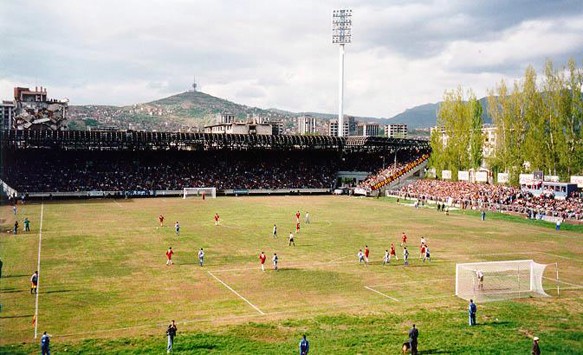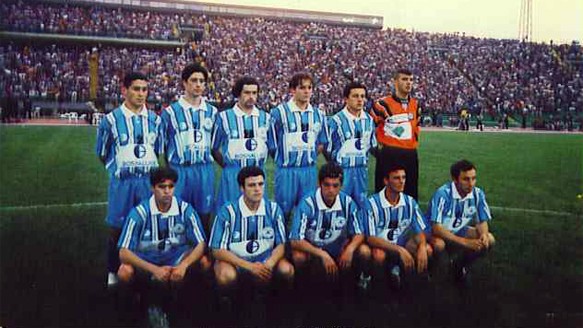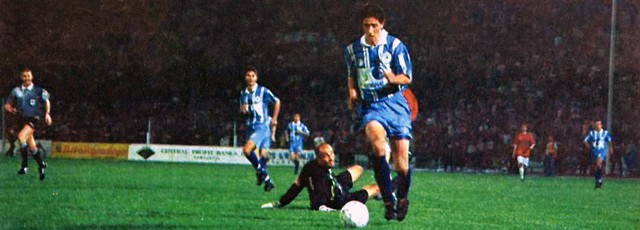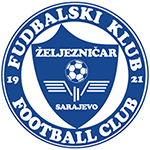The war could have easily spelled the definitive end for the club. The largest number of players left the club in search of salvation abroad. Many of them went on to have very successful careers, and some even became national team members for different countries. The Grbavica Stadium, located on the front line, was completely burned down in the first months of the war. The flames consumed not only the wooden western stand but also the club’s valuable documentation, as well as numerous trophies and memorabilia, which disappeared forever. Very little has been preserved, mostly what was found in club premises located in other parts of the city.
In general, the club was on the verge of shutting down, and there were discussions of such a possibility in some quarters. It could be said that the club had never faced a more difficult situation in its eighty-year history. No previous obstacle could compare to this, and even the shutdown during the Second World War was not as devastating to the club. However, everything that various enemies had failed to do before could not be achieved now either. In those challenging times, the supporters of the blue color decided that, as soon as the situation stabilized, they would do everything in their power to keep Željezničar alive. Mišo Smajlović, Edin Sprečo, Josip Bukal, Vasilije Radović, Boris Bračulj, Hajrudin Đurbuzović, Jusuf Šehović, Esad Ibrahimović, Josip Jurišić, Zdenko Jelić, Hajrudin Čengić, and several others were most responsible for the survival of the club. The players themselves were members of the BiH Army, and only futsal could be played, with training held in school halls in between their assignments on the front lines. Their love for the club was simply too strong.
At the height of the war, the club participated in the first BiH championship. Despite the almost impossible working conditions, Željezničar won first place in one of the qualifying tournaments, played in Sarajevo during the rare signed “armistice” period. This ensured them a place at the championship finals in Zenica. Although they won fourth place out of as many teams, just participating in that period was the biggest victory. It was proof that this time, as well as many times before, Željezničar could not be destroyed.
With the signing of the Dayton Peace Agreement in autumn of 1995, the war in our country came to an end. The football association quickly organized a league competition which included Željezničar. Unfortunately, many experienced players left the country and the club to seek better opportunities abroad. This left Željezničar with many young, inexperienced players. These beardless young men, who were still juniors, suddenly found themselves playing in the first league of their country. Despite their potential, which they would show in the years to come, more experienced teams, who were less affected by the war, proved too strong for them. Convincing defeats became a daily occurrence and after a few rounds, it seemed impossible for them to survive. Additionally, the club was unable to play their home games at the Grbavica stadium as it was still inaccessible.

FK Željezničar – FK Sarajevo 1:1
The improvement of the club’s situation came in the spring of 1996 when the entire settlement of Grbavica was reintegrated in March of that year and the club finally obtained its own stadium. The view of the stadium was depressing since it was destroyed, overgrown with weeds, and covered with shell debris. Additionally, one side of the stadium was directly adjacent to a mined area. Nevertheless, the enthusiasm of blue color enthusiasts came to the fore again, and the stadium was cleaned as much as possible. Already on May 2, 1996, a match was played there, which was a city derby with Sarajevo. The result was a draw (1:1), but it represented another, and much more important, victory for the club. In the spring part of that season, several more experienced players returned to the team from abroad, and Željezničar eventually reached a position in the middle of the table.
Mentioned young players gradually gathered matches and much-needed experience. In the 1996/1997 season, they showed for the first time that more could be expected from them. In the championship, they were not able to achieve more than seventh place, but Željezničar reached the final of the BiH Cup for the first time. Unfortunately, we were defeated by the city rival Sarajevo. When we entered the next season with a stronger team including a few more experienced players, the fans rightly expected more. However, what was achieved was not even expected by the greatest optimists.
The autumn part of the 1997/1998 season did not suggest a positive development or a positive outcome at the end of the season. The results were pretty bad, and a disappointing tenth place could not satisfy the appetites of loyal fans. However, everything changed after the winter break. During the break, Enver Hadžiabdić was appointed as the head of the coaching staff. With his appointment and a little more experience from the players, victories began to line up on the field. A great series of results raised the club’s ranking from round to round, but the top was still far away because Bosna from Visoko and Čelik dominated the league at that time.
At that time, three separate competitions were played in Bosnia and Herzegovina, and UEFA tried to convince their leaders to at least agree on a joint final if they could not agree on a joint league. In the end, such an agreement was reached, and the clubs that competed under NSBiH and NSHB played a joint final. However, representatives of the RS persistently denied any idea about joint competitions.
By the way, UEFA conditioned the possibility of playing in European competitions by clubs from Bosnia and Herzegovina with this agreement.
The agreement stipulated the formation of two groups, each comprising three clubs – one in Sarajevo and the other in Mostar. The league organized by NSBiH would provide four representatives. This meant that Željezničar had to finish among the top four teams to qualify for the playoffs. They succeeded in doing so and were further motivated by the prospect of playing in front of the Sarajevo crowd at Koševo. With a positive atmosphere and excellent results, our team defeated Bosna and Zrinjski. The second match against Zrinjski was particularly dramatic, as victory would secure first place, and the pressure was intense. Zrinjski proved to be a formidable opponent, and the match was tied at 1-1 until the final moments. To our great joy, Zubanović scored, prompting a huge celebration and securing a place in the final.
In the final, we faced our city rival. It was June 5, the final that the public could only dream of, as the Koševo stadium was full, the fans put on a spectacular show, and the game on the field was not bad either. It must be admitted that Sarajevo dominated most of the game, and Željezničar played perhaps the worst game of that spring. Captain Muharemović’s absence was really felt. However, despite that, it was a season in which everything went as we wanted it to. As the minutes ticked by, it seemed that the match would end goalless. What followed was something that would be permanently etched in the memories of recent generations of fans.

In the midst of the attack on Sarajevo, Pehlivanović reached a ball on the left side. He kicked the ball, which reached Šopović, who then excellently passed it into the empty space for the right-wing offensive player, Hadis Zubanović. Zubanović bypassed the opponent’s goalkeeper and scored, to the indescribable joy of Željo’s fans. That evening, one of the most beautiful pages in the club’s history was written, as Željezničar won the first title of champion of Bosnia and Herzegovina. This success was given special weight by the fact that the team was mostly made up of their own players, the same ones who, as beardless young men, played in the first BH league season.











